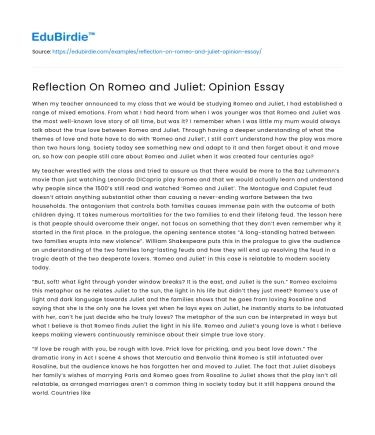When my teacher announced to my class that we would be studying Romeo and Juliet, I had established a range of mixed emotions. From what I had heard from when I was younger was that Romeo and Juliet was the most well-known love story of all time, but was it? I remember when I was little my mum would always talk about the true love between Romeo and Juliet. Through having a deeper understanding of what the themes of love and hate have to do with ‘Romeo and Juliet’, I still can’t understand how the play was more than two hours long. Society today see something new and adapt to it and then forget about it and move on, so how can people still care about Romeo and Juliet when it was created four centuries ago?
My teacher wrestled with the class and tried to assure us that there would be more to the Baz Luhrmann’s movie than just watching Leonardo DiCaprio play Romeo and that we would actually learn and understand why people since the 1500’s still read and watched ‘Romeo and Juliet’. The Montague and Capulet feud doesn’t attain anything substantial other than causing a never-ending warfare between the two households. The antagonism that controls both families causes immense pain with the outcome of both children dying. It takes numerous mortalities for the two families to end their lifelong feud. The lesson here is that people should overcome their anger, not focus on something that they don’t even remember why it started in the first place. In the prologue, the opening sentence states “A long-standing hatred between two families erupts into new violence”. William Shakespeare puts this in the prologue to give the audience an understanding of the two families long-lasting feuds and how they will end up resolving the feud in a tragic death of the two desperate lovers. ‘Romeo and Juliet’ in this case is relatable to modern society today.
Save your time!
We can take care of your essay
- Proper editing and formatting
- Free revision, title page, and bibliography
- Flexible prices and money-back guarantee
“But, soft! what light through yonder window breaks? It is the east, and Juliet is the sun.” Romeo exclaims this metaphor as he relates Juliet to the sun, the light in his life but didn’t they just meet? Romeo’s use of light and dark language towards Juliet and the families shows that he goes from loving Rosaline and saying that she is the only one he loves yet when he lays eyes on Juliet, he instantly starts to be infatuated with her, can’t he just decide who he truly loves? The metaphor of the sun can be interpreted in ways but what I believe is that Romeo finds Juliet the light in his life. Romeo and Juliet’s young love is what I believe keeps making viewers continuously reminisce about their simple true love story.
“If love be rough with you, be rough with love. Prick love for pricking, and you beat love down.” The dramatic irony in Act I scene 4 shows that Mercutio and Benvolio think Romeo is still infatuated over Rosaline, but the audience knows he has forgotten her and moved to Juliet. The fact that Juliet disobeys her family’s wishes of marrying Paris and Romeo goes from Rosaline to Juliet shows that the play isn’t all relatable, as arranged marriages aren’t a common thing in society today but it still happens around the world. Countries like India experience unfair laws continuously in their day to day lives. India is one of the countries where the female population is less than the proportion of the male population. The patriarchal society that Juliet lives in is relatable today. Women today are still not seen as equal around the world, women everyday are fighting for equal rights and men are seen overpowering women around the globe. Many factors of the playwright William Shakespeare’s play Romeo and Juliet are relevant and relatable. Many factors of the play could be considered very 1500’s especially his use of Shakespearean language in the portrayal of the patriarchal society. Lord Capulet and Paris discuss the marriage of Juliet and Paris when they exclaim “My child is yet a stranger in the world.... Ere we may think her ripe to be a bride. Younger than she are happy mothers made.” Girls who were brought up in a wealthy family during the Shakespearean times didn’t have a choice in choosing who they should love. Marriages weren’t planned to make the couple happy but to rather make the families happy.
The play forces the audience to digest the themes of love and hate. William Shakespeare’s use of imagery and metaphors forces the audience to feel Romeo and Juliet’s true love relationship. Shakespeare uses imagery highlights emotion. In using imagery, he conveys Tybalt's anger for Romeo's disturbance, which shows the strain between the two families. In Act 2 scene 2, the imagery is continued, when Romeo is talking to Juliet on the balcony he is looking up at her.
Its everlasting themes of love and hate genuinely allow people to relate to the play. Its unforgettable protagonists deeply affect the minds of the readers. Its magnificent language which many writers today honour in admiration are all reasons for the play’s timelessness. The two “star-crossed” lovers who are forbidden to love each other struggle to comprehend how their families’ feuds would ever come to a conclusion. The play’s universal because people can thoroughly relate to the themes such and love, violence, death and hate and these refrains make up the timeless play. Romeo and Juliet’s timelessness will continue and has developed the ideas that the themes of violence, love and hate will continue to be learnt by students, read by adults, and enjoyed by everyone.






 Stuck on your essay?
Stuck on your essay?

